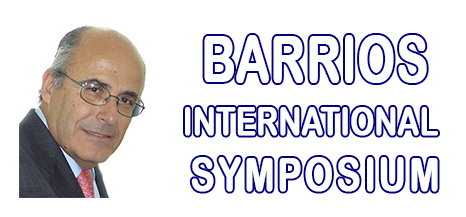List of Accepted Abstracts As of 19/12/2025: (Alphabetical Order)
Barrios Intl. Symp on Sustainable Non-ferrous Smelting and Hydro/Electrochemical Processing
Dodds Intl Symp: on Sustainable Energy Production: Fossil; Renewables; Nuclear; Waste handling , processing, and storage for all energy production technologies; Energy conservation
Gaune-Escard Intl Symp: on Sustainable Molten Salt and Ionic Liquid Processing
Goodall Intl. Symp. on Sustainability of World Ecosystems in Anthropocene Era
Lotter Intl Symp. on Sustainable Mineral Processing: Principles, Technologies and Industrial Practice
Marquis Intl. Symp. on New and Advanced Materials and Technologies for Energy, Environment and Sustainable Development
Intl. Symp. on Advanced Sustainable Iron and Steel Making
Intl. Symp. on Sustainable Metals & Alloys Processing
Intl. Symp. on Sustainable Aluminum Extraction and Processing
Intl. Symp. on Sustainable Secondary Battery Manufacturing and Recycling
Intl. Symp. on Multiscale Material Mechanics and Multiphysics and Sustainable Applications
Intl. Symp. on Sustainable Mathematics Applications
Intl. Symp. on Sustainable Surface and Interface Engineering: Coatings for Extreme Environments
Intl. Symp. on Composite, Ceramic and Nano Materials Processing, Characterization and Applications
Intl. Symp. on Environmental, Health, Policy, Legal, Management and Social Issues Related to Metals, Materials and Mineral Processing
Intl. Symp. on Sustainable Mining Operations
Intl. Symp. on Synthesis and Properties of Nanomaterials for Future Energy Demands
Intl. Symp. on Rare Earth and Platinum Group Metals: Managing and Processing
Intl. Symp. on Sustainable Materials Recycling Processes and Products
Intl. Symp. Surfaces and Interfaces of Sustainable, Advanced Materials (SISAM)
Summit Plenary
INTL. SYMP. ON RARE EARTH AND PLATINUM GROUP METALS: MANAGING AND PROCESSINGTo be Updated with new approved abstracts Precipitation Properties of Neodymium and Dysprosium Double Salt in Sulfuric Acid Leaching Solution from Permanent Magnet Scrap
Chul Joo
Kim1; Ho-sung Yoon1; Kyeong Woo Chung1;
1KOREA INSTITUTE OF GEOSCIENCE AND MINERAL RESOURCES (KIGAM), Daejeon, Korea (Republic of [South] Korea);
Type of Paper: Regular
Type of Presentation: Poster
Id Paper: 51
Topic: 11In this study, the precipitation of rare earth-sodium sulfate was conducted in order to separate rare earth from Fe in rare earth sulfate solution. The rare earth sulfate solution could be obtained by sulfuric acid leaching of waste permanent magnet scrap oxidizing-roasted. The method of double salt precipitation was used for the selective recovery of rare earth elements from leach liquor. Rare earth elements could be precipitated as a form of sodium rare earth sulfate with sodium sulfate in sulfuric media. Therefore the effects of sodium sulfate, reaction temperature and reaction time on the recovery of rare earth element were surveyed during double salt precipitation. Neodymium(Nd) was easily precipitated as Nd-sulfate salt with sodium sulfate, on the other hand, excessive sodium sulfate was needed for the precipitation of Dy-sulfate salt. Also neodymium not only promoted the precipitation of dysprosium sulfate salt but also increased recovery of dysprosium sulfate salt in sulfuric acid solution. At the condition of 60ĦE precipitation temperature, 3h reaction time, 7 equivalents sodium sulfate, the recovery of neodymium and dysprosium sulfate salt was 99.7% and 94.3% respectively from the sulfuric acid solution containing Nd of 23.39mg/ml and Dy of 8.67mg/ml.
Keywords: Hydrometallurgy; Magnet; RareEarth; Recovery; Recycling; Sustainable;
Recovery of Rare Earths Elements from Neodymium Magnets using Solvent Extraction: the Effect of Diluents
Marino
Gergoric1; Teodora Retegan1;
1CHALMERS UNIVERSITY OF TECHNOLOGY, Gothenburg, Sweden;
Type of Paper: Regular
Type of Presentation: Poster
Id Paper: 72
Topic: 11Rare earth elements (REEs) have become vital components in a wide range of industrial applications. The demand for the REEs has grown significantly in the last few decades.Today, despite lower prices than in 2011, they are classified as the highest supply risk elements in the EU; thus new incentives for recycling the REEs out of electronic scrap were brought forth. End-of-life neodymium magnets are a viable source for the recovery of some REEs. Although mainly iron alloys, these materials contain neodymium, dysprosium and small admixtures of praseodymium and terbium. Leaching followed by solvent extraction of the REEs out of the leachate is an attractive and efficient way of recycling these elements out of end-of-life neodymium magnets. The issues that are encountered along this recycling path is the separation of the REEs from the other elements that are dissolved with the REEs into the leachate and achieving high separation factors between the REEs from each other. Extracting agents such as D2EHPA (di(2-ethylhexyl)phosphoric acid) and TODGA (tetraoctyl diglycolamide) have been previously used for achieving good separation of the REEs under specific extraction conditions. This research has focused on the development and optimization of REE extraction from real commercial waste sources, the nitric acid and sulfuric acid media leachates of the neodymium magnet waste, using TODGA and D2EHPA as extracting agents, respectively. Selective REE extraction from the solution with minimal or no co-extraction of other elements in the leachate is hoped to provide a novel route to a commercially viable route to recyclable REE products. The composition of the organic phase was investigated in order to study the effect of the diluent on the overall extraction process, a well-known optimization parameter, however infrequently used. The effect of the diluent on the separation factors was also discussed as well as some characteristics of the aqueous phase on the overall extraction process. The named extractants were used at various concentrations in different diluents like solvent 70, hexane, octane, cyclohexanone, toluene, 1-octanol and chloroform. Both extractants showed good selectivity concerning the extraction of the REEs out of the neodymium magnet waste leachates.
Keywords: Hydrometallurgy; RareEarth; Recovery; Recycling; Sustainable;
Selective Recovery of Rare earth elements from NdFeB powders by using caustic digestion and oxidation roasting
Ho-sung
Yoon1; Chul Joo Kim1; Kyeong Woo Chung1;
1KOREA INSTITUTE OF GEOSCIENCE AND MINERAL RESOURCES (KIGAM), Daejeon, Korea (Republic of [South] Korea);
Type of Paper: Regular
Type of Presentation: Poster
Id Paper: 50
Topic: 11With increasing use of NdFeB magnets, an abundance of waste magnets has been gradually released from end-of-life devices and systems. In addition, the generation of scrap materials is simultaneously increasing because more than 20% of the input amount is discharged as waste scrap during the manufacturing process. Therefore, their recycling has attracted much attention and several methods based on pyro/hydro-metallurgy for recovering valuable metals from magnet alloys have been developed.
Hydrometallurgical process consists of leaching, separation and purification and recovery of rare earth elements(REEs) as compounds and metals. Upon the application of NdFeB powders to acid leaching without pretreatment, iron as well as REEs are leached, which consumes large amount of acid and generated the large amount of FeSO4 waste solution. To avoid this, oxidation roasting and acid leaching of NdFeB powders have been suggested, however, this methods shows still relatively high leaching of iron due to the formation of mixed oxide, FeNdO3.
In this work, caustic digestion and oxidation roasting method is suggested. In alkaline region, neodymium and iron can be transformed to neodymium hydroxide and magnetite like this. Then oxidation roasting of these powders gives rise to the formation of neodymium oxides and iron oxides, respectively. The leaching of resultant powders reveals high recovery yield of REEs of more than 90% and very low recovery yield of iron of below 1%.
More details will be discussed in the presentation.
Keywords: Environment; Extraction; Hydrometallurgy; Industry; Magnet; RareEarth; Recovery; Recycling; Sustainable; Technology;
|







